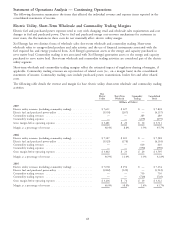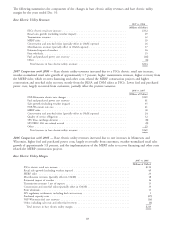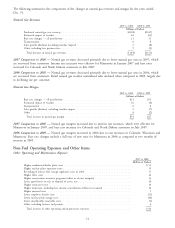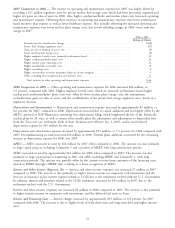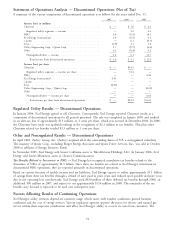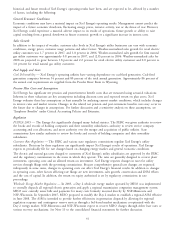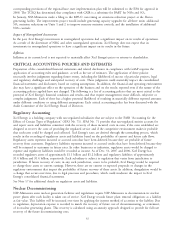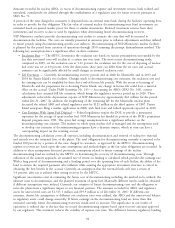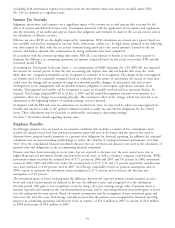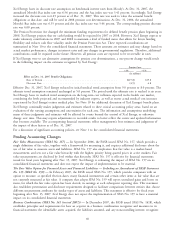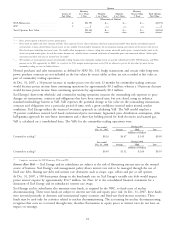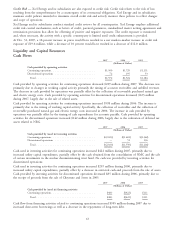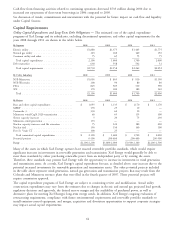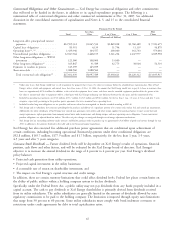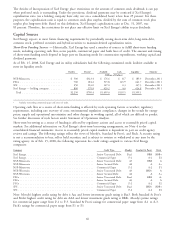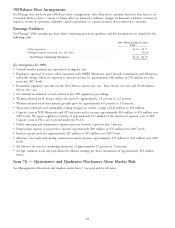Xcel Energy 2007 Annual Report Download - page 68
Download and view the complete annual report
Please find page 68 of the 2007 Xcel Energy annual report below. You can navigate through the pages in the report by either clicking on the pages listed below, or by using the keyword search tool below to find specific information within the annual report.
Amounts recorded for nuclear AROs, in excess of decommissioning expense and investment returns, both realized and
unrealized, cumulatively are deferred through the establishment of a regulatory asset for future recovery pursuant to
SFAS No. 71.
A portion of the rates charged to customers is deposited into an external trust fund, during the facilities’ operating lives,
in order to provide for this obligation. The fair value of external nuclear decommissioning trust fund investments are
estimated based on quoted market prices for those or similar investments. Realized investment returns from these
investments and recovery to date is used by regulators when determining future decommissioning recovery.
NSP-Minnesota conducts periodic decommissioning cost studies to estimate the costs that will be incurred to
decommission the facilities. The costs are initially presented in amounts prior to inflation adjustments and then inflated
to future periods using decommissioning specific cost inflators. Decommissioning of NSP-Minnesota’s nuclear facilities
is planned for the period from cessation of operations through 2050 assuming the prompt dismantlement method. The
following key assumptions have a significant effect on these estimates:
• Escalation Rate — The MPUC determines the escalation rate based on various presumptions surrounded by the
fact that associated costs will escalate at a certain rate over time. The most recent decommissioning study,
completed in 2005, set the escalation rate at 3.61 percent. An escalation rate for the cost of disposing of nuclear
fuel waste was set at 6.0 percent. Over the short-term, these rates can differ from the set rates and accrual
estimates can be significantly affected by small changes in assumed escalation rates.
• Life Extension — Currently, decommissioning recovery periods end in 2020 for Monticello and in 2013 and
2014 for Prairie Island’s two facilities. Changes made to decommissioning cost estimates, the escalation rate and
the earnings rate can be amplified by these short end-of-license life periods. With the recent re-licensing of
Monticello and the preparation for re-licensing Prairie Island, any change in license life could have a material
effect on the accrual. Under FASB Statement No. 143 — Accounting for AROs (SFAS No. 143), current
calculations have assumed full life extension, which brings the regulatory recovery period up to 2020. These
adjustments reduced the depreciation expense of NSP-Minnesota by approximately $41 million for the period
ended Dec.31, 2007. In addition, the lengthening of the remaining life for the Monticello nuclear plant
decreased the related ARO and related regulatory asset by $121 million in the third quarter of 2007. Prairie
Island anticipates filing a similar application in 2008, with final state and federal approvals expected in 2010.
• Cost Estimate With Spent Fuel Disposal — Federal regulations require the DOE to provide a permanent
repository for the storage of spent nuclear fuel. NSP-Minnesota has funded its portion of the DOE’s permanent
disposal program since 1981. The spent fuel storage assumptions have a significant influence on the
decommissioning cost estimate. The manner in which spent nuclear fuel is managed and the assumptions used
to develop cost estimates of decommissioning programs have a dramatic impact, which in turn can have a
corresponding impact on the resulting accrual.
The decommissioning calculation covers all expenses, including decontamination and removal of radioactive material,
and extends over the estimated lives of the plants. The total obligation for decommissioning currently is expected to be
funded 100 percent by a portion of the rates charged to customers, as approved by the MPUC. Decommissioning
expense recoveries are based upon the same assumptions and methodologies as the fair value obligations are recorded. In
addition to these assumptions discussed previously, assumptions related to future earnings of the nuclear
decommissioning fund are utilized by the MPUC in determining the recovery of decommissioning costs. Through
utilization of the annuity approach, an assumed rate of return on funding is calculated which provides the earnings rate.
With a long period of decommissioning and a funding period over the operating lives of each facility, the ability of the
fund to sustain the required payments after inflation while assuring the appropriate investment structure is critical in
obtaining the best benefit in the accrual. Currently, an assumption that the external funds will earn a return of
5.4 percent, after tax is utilized when setting recovery by the MPUC.
Significant uncertainties exist in estimating the future cost of decommissioning including the method to be utilized, the
ultimate costs to decommission, and the planned treatment of spent fuel. Materially different results could be obtained
if different assumptions were utilized. Currently, our estimates of future decommissioning costs and the obligation to
retire the plants have a significant impact to our financial position. The amounts recorded for AROs and regulatory
assets for unrecovered costs are $1,315.1 million and $39.9 million as of December 31, 2007. If different cost
estimates, shorter life assumptions or different cost escalation rates were utilized, this ARO and the unrecovered balance
in regulatory assets could change materially. If future earnings on the decommissioning fund are lower than that
estimated currently, future decommissioning recoveries would need to increase. The significance to our results of
operations is reduced due to the fact that we record decommissioning expense based upon recovery amounts approved
by our regulators. This treatment reduces the volatility of expense over time. The difference between regulatory funding
58


